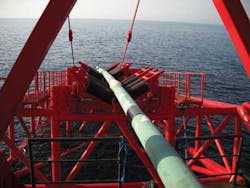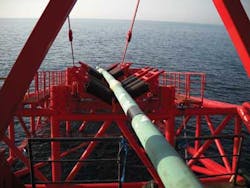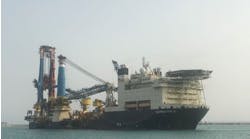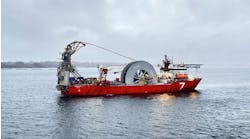Bruce Beaubouef
Managing Editor
Operators and developers are studying, planning, and building almost 5,600 mi (9,012 km) of oil and gas pipelines to bring these supplies from offshore fields to onshore markets. The total reflects a slight decrease compared to last year's report, which showed a total of nearly 5,800 mi (9,334 km).
The decrease is due to the completion of a number of offshore pipeline projects, including the 149-mi (240-km), 18-in. SEKCO oil pipeline in the Gulf of Mexico, which was completed this year.
The most active regions for offshore pipeline construction remain the same as last year - and in the same order - with Europe, the Middle East, South Pacific, and the Gulf of Mexico leading the tally.
Europe remains the clear leader in offshore pipeline projects, with more than 2,700 mi (4,345 km) of systems being built and planned. That marks an increase over last year's total of 2,553 mi (4,109 km). The largest project being planned offshore Europe is the South Stream pipeline. It would move Russian gas through the Black Sea to Bulgaria and other markets through a 560-mi (901-km), 32-in. pipeline to be installed in waters down to more than 7,300 ft (2,225 m). Developers Gazprom and Eni say that offshore pipelay on this project will begin next spring.
The Middle East is the next most active region, with nearly 1,011 mi (1,527 km) of oil and gas pipelines being built and planned. That total marks a slight decrease from last year's total of 1,084 mi (1,745 km). The most notable project in this region - and a big contributor to the region's total - is the proposed South Asia Gas Enterprise (SAGE) pipeline project, which proposes to move natural gas from the Oman Middle East Compression Station (MECS) to Gujarat, India, by building 807 mi (1,299 km) of 24 to 27-in. pipe through the Arabian Sea, in waters down to 11,100 ft (3,383 m). The project is currently under study, and project developers are looking at a 2017 in-service date.
The South Pacific is another active region for offshore pipeline work, with Chevron's Wheatstone and INPEX's Ichthys projects both having associated pipeline systems as part of the development. Work is currently under way on the 140-mi (225-km), 44-in. Wheatstone gas trunkline, with construction contractor Allseas currently installing the system.
The biggest offshore pipeline project in the South Pacific is associated with the Ichthys project offshore Western Australia. It calls for 552 mi (888 km) of 42-in. pipe to move gas from an offshore processing facility to shore at Darwin, Australia. Work is also under way on this project, and installation contactor Saipem is targeting a 2014 completion date.
In the Gulf of Mexico, Williams reports that work is under way on the Keathley Canyon Connector project. It involves the construction of a 215-mi (346-km), 20-in. pipeline to gather production from the Keathley Canyon, Walker Ridge, and Green Canyon areas in the central deepwater Gulf. Saipem is laying the line in waters down to 7,380 ft (2,249 m), and the overall project is scheduled for a mid-2014 in-service date.
Offshore South America, Petrobras is also moving forward with plans to move gas from the Guara and Lula Northeast FPSOs in its Lula field to other systems that will take the gas to onshore markets. A joint venture of Eni and Repsol has announced plans for a new export gas line offshore Venezuela. Work here will involve the construction of a nearly 42-mi (68-km), 30-in., pipeline in the Cardón IV block in the Gulf of Venezuela.
This second annual Global Offshore Pipeline Construction Survey - a detailed project-by-project listing of all the major large-diameter offshore oil and gas pipeline systems being built, planned, and studied - begins below.
Click here to view theGlobal Offshore Pipeline Construction Survey




